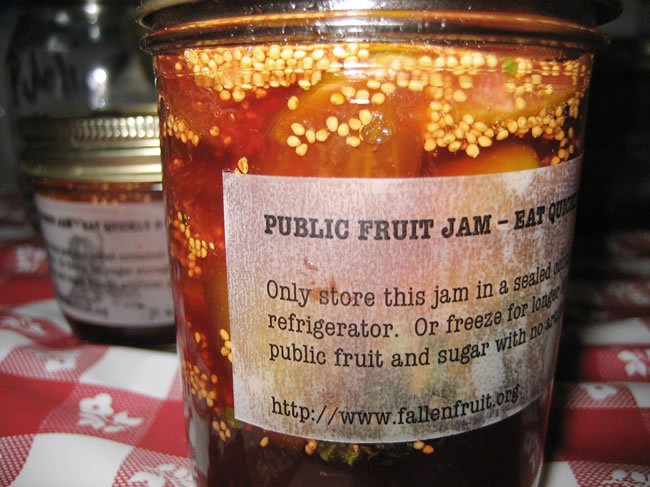Mangos, Calamondins And Surinam Cherries? Oh, Yes!
In meditation, in vodka, on the walls, squished up in bottles … in all kinds of unique ways, fruit is about to invade Honolulu. Yes, it’s summer, so mango, lychee, lilikoi – a cornucopia of tropical delights – are in season, and L.A.-based artist trio Fallen Fruit (David Burns, Austin Young and Matias Viegener) is about to ply our minds and palates with their special cocktail of humor, politics, jam-making and more, revolving around fruit. It’s all part of the inaugural Find Art: Celebrating Community + Creativity festival inundating Chinatown June 28 to 30.
“Fallen Fruit captures so much of what we want in a festival – bringing people together, collaboration, community, discovery, having fun,” says festival co-organizer and curator of the visual arts program Trisha Lagaso Goldberg. “We want to bring non-Chinatown people into Chinatown, and bring local people, passersby and tourists all together. Fallen Fruit provides us with a great opportunity to mix and match and have unexpected surprises happen. They are used to looking at cultures as the outsider and insider – I wanted to bring an outsider perspective in understanding how fruit gets to places and carries messages and the politics of fruit. They can help us look at our own culture and what’s around us in a new light.”
Burns and Young, a dynamic duo, sat down with A&S to share the juicy details about their Hawaii performances:
Fallen Fruit got its start when you made a map of fruit trees in your neighborhood. How did it progress into performing around the globe?
Burns: Nobody really walks in Los Angeles. Their experience of “place” is mediated by wind-shields or cell phones, so we made this map, which functions like a treasure map. There are no addresses, so you really have to get out there and explore. The idea of transforming our project into different kinds of experiences that have mystery made a lot of sense to us. Our Public Fruit Jam has no recipes, and the Fruit Meditation coming up at the Honolulu Museum of Art is not exactly a meditation.
Young: Everything we do is about bringing people together. With the Fruit Jam, you get to sit next to somebody you would never know and talk to them about memories of fruit, or maybe how your family grew papayas or worked on a pineapple plantation. What we discovered is you then start to find this history of place and family around these public events that we create.
Why fruit?
Burns: We’ve learned by doing this project over the last eight years that fruit is an amazing object. We think it’s natural, but it’s not. It’s a negotiation between the natural and the cultural. It was created by people all over the world for thousands of years selecting the best choice. It doesn’t have any class boundaries. The richest people in the world and the poorest both eat the same bananas. Fruit is a symbol of goodness in every culture in the world. It has no religious affiliation per se. It equalizes broad categories of people. A child and grandparent can both be an expert on the flavor of pineapple or strawberries. It’s a lovely way to create connection.
Cultivating fruit is a process of selection, and it’s the same with history. We go through this process of selecting images, of selecting stories. And we move that story forward. We’re “cultivating” history and knowledge. That’s part of what we work on in this project. We use our actions as ways to negotiate experience in content and meaning and that’s why we think of it as art. Some people get really stuck on “Is fruit art? Like, where’s the ‘art’ part?” And that’s one of the reasons we love the “Find Art” festival.
What happens in the Fruit Meditation?
Burns: We take a group of people who hopefully don’t know each other, and we have really personal and group experiences. They’re based on guided meditation practices and group dynamics, mostly from the ’70s and ’80s, with just a bit of New Age thrown in. And it’s all wrapped up with fruit. (Space is limited. To participate, email apadilla@honolulumuseum.org asap.)
And the Fruit Jam?
Young: It’s complete organized chaos. Bring fruit and we’re going to have group jam-making.
Burns: Go to your friend’s house, pick what’s in season. Bring them from your backyard. We’ll make jam out of any fruit you can find. I bet papaya would make a really weird jam. I bet guava would make a really good jam. But then there’s mangos. I imagine it would be like jamming with a banana.
Young: If you showed up with family and friends, we’re going to so quickly invite you not to hang out with people you know. So you’re hanging out with someone else’s grandma, and that grandma is telling you stories about her family and it’s probably an amazing story. What we really love about these opportunities with the public is creating connections that create meaningful experience.
You must get this a lot, but what’s your favorite fruit?
Burns: It changes all the time. For this interview it’s going to be the Surinam cherry.
Young: Mine is papaya. I hear the Surinam cherry is sour … that’s a perfect fruit for jam. Bring your Surinam cherries!
Burns: Also bring calamondins, because calamondin jam is out of control!
the TICKET stub
When: June 28-30
Where: Venues throughout Chinatown
Cost: Free
More Info:Findartfestival.com, fallenfruit.org, facebook.com/fallenfruit






